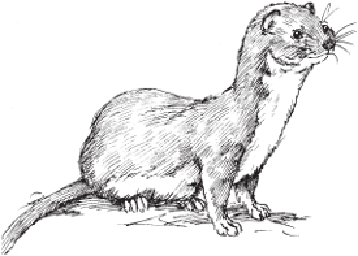Agriculture Reference
In-Depth Information
I grew up out West and dealt with rattlesnakes that would invade the poultry yard
periodically to make a meal of young fowl. Here in Iowa, I have many snakes on the
farm; fortunately no rattlesnakes inhabit the region, but a large number of bull snakes
(
Pituophis catenifer
) do, and they are a great help in rodent control. Occasionally, these
snakes get a taste for eggs, and some days I have had a bit of excitement, shoving my
hand in a nest only to find a cool, slick reptile coiled up instead of a clutch of eggs.
Rarely do they find their way into the brooder house and take a young bird.
I have had reports from some parts of the country where other species such as black
snakes are very fond of poultry. Therefore we must remember not all of our predator
problems are warm-blooded. The important thing is to watch for them and remove them.
Weasel
Weasels are small, ruthless killers who get to your birds through the smallest of holes:
a hole the size of a quarter is enough for a chicken dinner. Once they start killing, they
don't stop. More than once, I've opened up a building and found nothing but dead birds.
Birds usually are found with two holes in the neck where a weasel has grabbed it and
then left the chicken to bleed to death. Lots of feathers scattered about strewn, ruffled
bodies or birds lying grouped in a corner where they ran for cover before being killed
are other clues to a weasel attack.
If you live in an area where weasels are abundant, you probably will end up having
this problem at some point in your poultry-raising experience. Keep your buildings and
bird facilities maintained to ensure that there are no holes big enough for even your
thumb to fit through.
A weasel can enter a building through a hole the size of a quarter.
When I was a child growing up in the mountains of the West, we had serious weasel
problems. I had to take great care to make sure all holes in the building were sealed off

